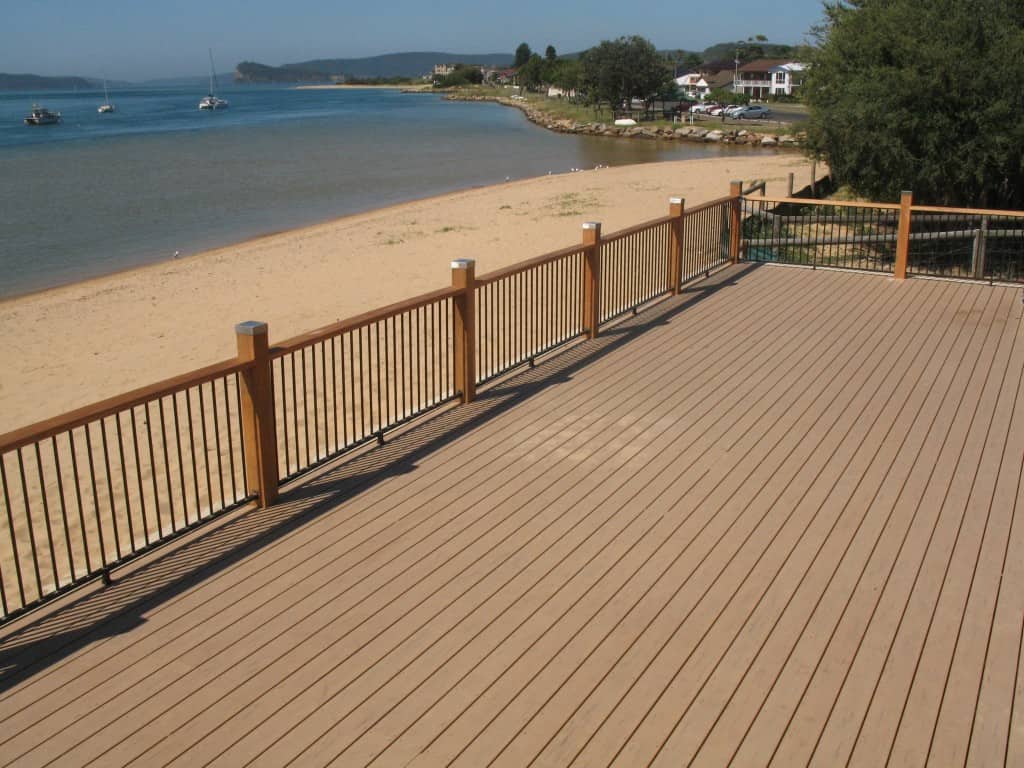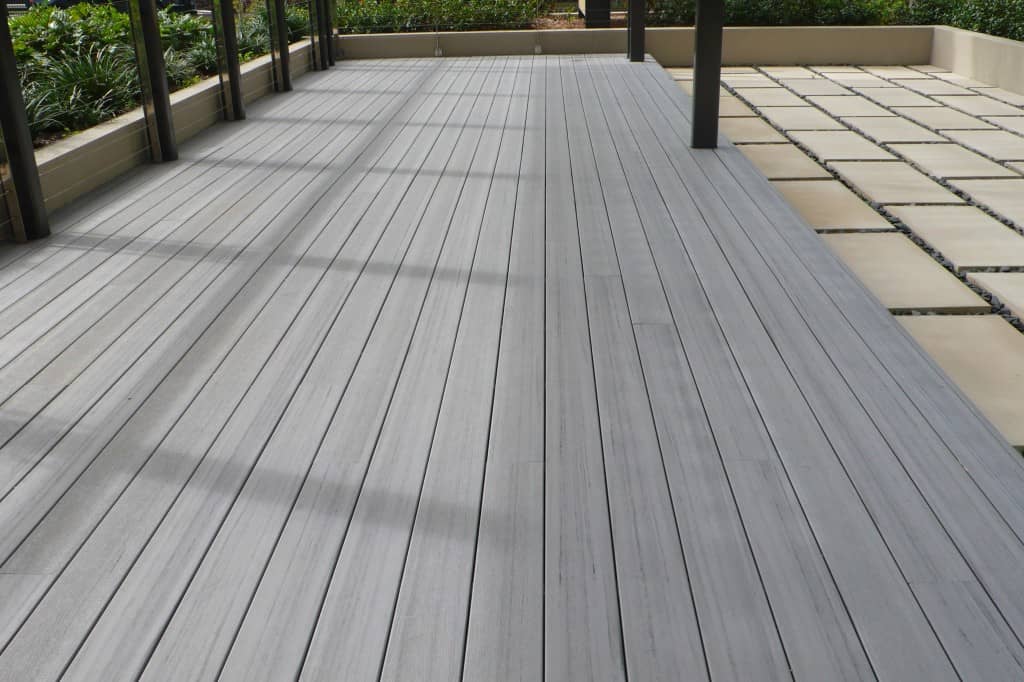Has wood-plastic come of age?
Wood plastic composite (WPC) decking has improved in many ways over the years and nowadays accounts for a very large chunk of the decking market. Ted Riddle discusses what to look for.
In my days in the Timber Advisory Service, the only time we heard the term ‘plastic wood’ was in conjunction with wood fillers, patching holes and the like. But almost every time I participate on the ABC Sydney ‘Homies’ radio program on Saturday mornings, I’m asked about ‘plastic wood decking’: what’s the best, and/or can I make a recommendation.
I remember well the early introduction of these ‘plastic wood’ decking boards. They are, of course, more correctly called ‘wood plastic composites’ or WPC – and they’ve really come of age in recent times. Being an old timber man, WPC is something that I’ve never really considered, but there’s no doubt that as decking, cladding, fencing, external screening etc. it’s become a big part of the market.
WPC decking was the first ‘plastic wood’ product to appear in the Australian market, and its development goes back some 15 – 20 years in the US, where today it holds about 19% of the total decking market – a share that’s expected to grow by about 12% per annum over the next 5 years.

How WPC has grown
In those early years in the US, the product had a number of drawbacks including surface flaking, tannin bleed (the stain that can occur on the surface of timber decking) and not really living up to expectations in regard to mildew and discolouration. It certainly didn’t meet the original ‘maintenance free’ guarantee it was promoted with.
These days there are many different brands, different profiles and different colours to choose from, but you need to make sure that when making the decision you make it for the right reasons – not just colour or price.
It wasn’t until I started to look closely at the various brands that I realised there are almost as many different manufacturing processes and potential contents. This makes it very hard to compare each as equals.
Polyethylene is the most common base for WPC, but there are at least another six thermoplastic resins that are used, including things like polyvinyl chloride (PVC) and polypropylene (PP). Each base offers slightly different properties, costs and environmental credentials.
In Australian manufacturing, high-density polyethylene (HDPE) is the preferred plastic. This is generally sourced from recycled milk bottles, which gives the local products great sustainability ratings. Having said that, because of the composition of plastics in general, WPCs are not usually as strong as timber – particularly high density Australian hardwoods.
The other basic component of the WPC is the wood flour. Wood flour is made by crushing wood fibre into a fine powder, the consistency of which is very important in making the WPC. If the grains are too big or irregular, the integrity and performance of the end product can’t be assured.
Although not a commonly known material, wood flour as a by product of the timber industry has a history going back over a century, and has been used in the manufacture of Bakelite and linoleum. It’s also been used in wood fillers and in cooling and filtration systems to plug leaks – any excess that flows off is readily biodegradable.
There are also other fillers that are used in the WPC mix, including colouring agents, binding or coupling agents to help the plastic and wood flour bond, UV stabilisers, (sometimes) mineral fillers to reduce cost, and lubricants and other additives to help make the material easier to extrude and mould.
Environmental credentials
In Australia, two major manufacturers, ModWood and Advanced Plastic Recycling (APR), claim they use all recycled timber fibre; ModWood claims to use the residue from plantation pine softwood milling operations, and APR indicates that it uses a wide range of all recycled timber as its base resource. My understanding is that having a set species base provides a more consistent outcome, although using mixed species is common in the production of wood flour where recycling timber is a major factor in its environmental worth.
Environmental sustainability is certainly one of the driving factors behind the emergence of WPC as a popular decking product, but not all products are equal in this aspect. Many overseas producers use virgin plastics (not from recycled suppliers) and use new timber as a more economical resource for their wood fibre. Some also mix in other fibre sources such as peanut hulls (shells), bamboo, straw and other vegetable matter waste (in addition to the mineral waste). These added materials can all obviously reduce costs, but it may be at the expense of product quality.

The long run
Lack of maintenance is clearly a major selling point, as is colour fastness, but neither of these are 100% guaranteed. Customers need to understand that without doubt the better quality products (probably at the pricier end of the market) will perform better, but the owner will have to clean the surface a few times a year. In some cases with WPC products manufactured in Asia, tannin bleed continues to be a problem. In these cases the wood flour is produced using rainforest hardwoods, most of which contain high levels of tannin, and the staining or bleed can cause surface discolouration or marks on mats, towels and the like. Decks installed over car parks can cause significant problems if the tannin stain drips onto to the paintwork of cars parked below.
After the first few months of service the colour will fade a little – nothing is totally UV resistant. Like timber decking, some mildew and fungus can also develop, particularly in south facing areas that are open to the weather but don’t get a lot of direct sunlight. Some degradation can occur – there’s timber fibre in the product, and timber does decay over time.
For WPC products that claim high life expectancies and low maintenance (or still in some cases, nil maintenance), guarantees and warranties are an important factor. Certainly you or your client have statutory warranties, either stated or implied by state consumer protection laws, but to my mind written guarantees give you greater confidence in the product – and they’ll make your client a bit more confident about the product they choose.
I have been quite surprised to see that some suppliers don’t offer any warranty to back up their rhetoric about the product either – that’s always a good indicator to me that you need to be wary. Of course all the due diligence in the world can’t foretell a fly-by-night reseller going out of business without the backing of an unknown producer from some obscure corner of the world; but you can guess who will be left carrying the can if the product packs it in within the builder’s six or seven year warranty period.
The same only very different
Lack of repeatability (i.e. the long term availability of extra or replacements boards), being designed for a different country’s building standards and not being developed to handle the harsh Australian environment are the big drawbacks of using some imported materials!
Apart from the considerations of colour, profile and fixing (i.e. face fixed nails or screws or secret fix), I think one of the best indicators of quality and long term performance is a product’s fire rating. WPCs are certainly heat sensitive, and can react adversely in severe conditions. Combustibility and some possible melting are potential issues when WPC decks are close to or involved with fires. As such, building code regulators have shown concern, particularly with decking, in bushfire prone areas.
In many cases if you’re doing a renovation or you’re building in a suburban location that’s not in a bushfire prone area, you may not otherwise take fire ratings into consideration – but again I stress that if the manufacturer has done development on bushfire ratings and is marketing a product or a range that can be used in varying fire rated conditions, you’re probably looking at a good quality product that is going to be fit for purpose.
Back on the radio program, I stop short of recommending a brand (the ABC frowns on that) but what I do recommend is that the Australian made decking looks to be the best value for money. From the builder’s perspective, WPC decking is one of those products that you should get your client to choose, making sure, as I said before, that they don’t just choose on price and colour alone; in this instance the old adage ‘you get what you pay for’ is very much true.
Ted Riddle has 47 years’ experience in the timber industry as a merchant, importer, producer and marketer.
